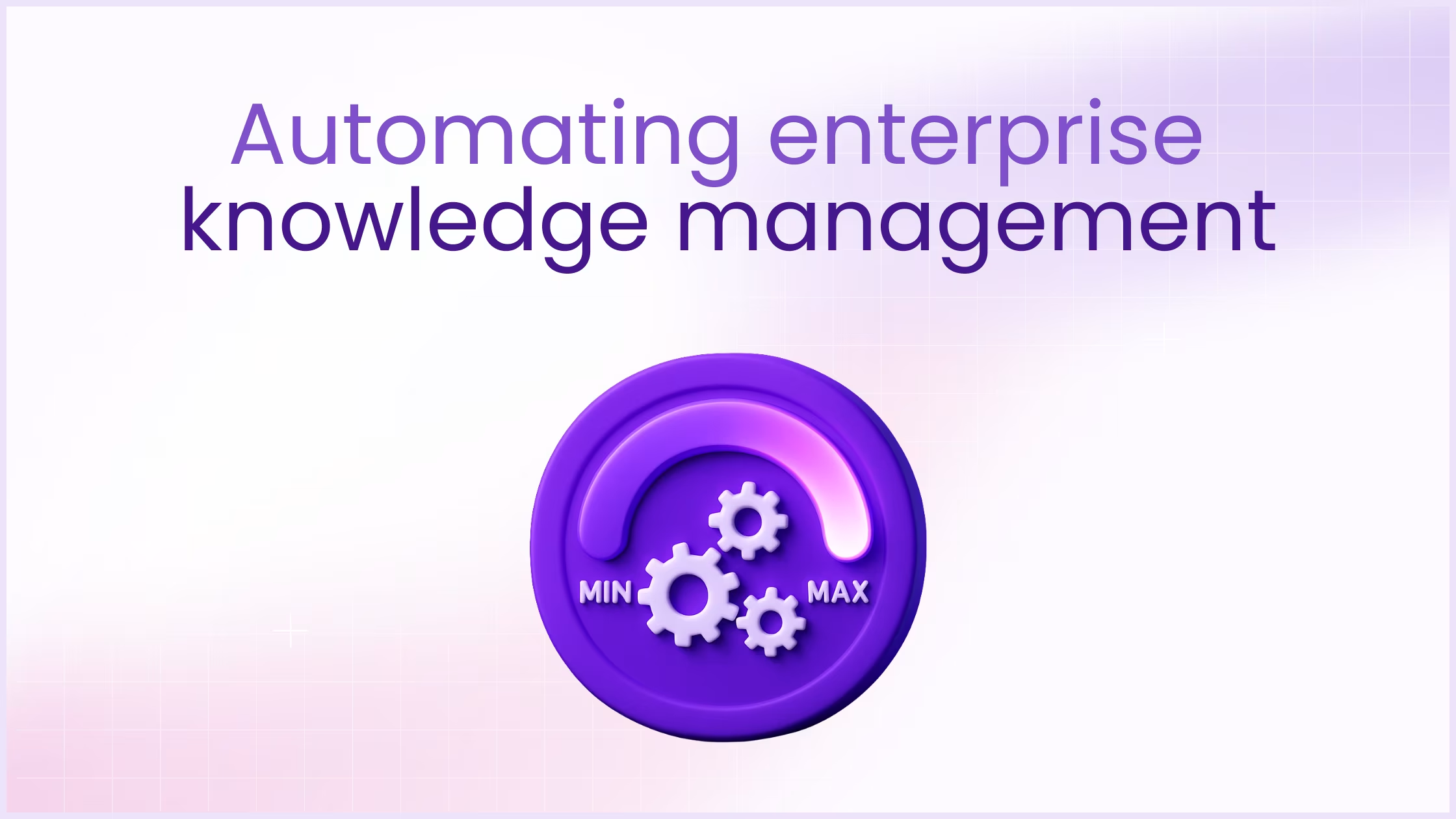Modern enterprises are drowning in information, but not always the kind that's accessible when it matters. Despite investing in a range of knowledge management products, many organizations still struggle with disconnected tools, fragmented content, and lost context. These barriers, commonly known as knowledge silos or data silos, not only stall innovation but also disrupt collaboration and reduce overall productivity.
Enter smart automation, a game-changer in how companies manage institutional knowledge. With artificial intelligence-powered capabilities now embedded across today's knowledge management software, enterprises are moving from manual, error-prone processes to intelligent systems that connect people to the right information at the right time.
In this blog, we explore how automation transforms enterprise knowledge management. From semantic search to AI content discovery, you'll see how advanced knowledge tools help break down information silos, elevate productivity, and build scalable knowledge infrastructures.
What is enterprise knowledge management?
At its core, enterprise knowledge management is the systematic process of capturing, organizing, distributing, and using knowledge across an organization. It encompasses structured data, unstructured documents, tacit expertise from subject matter experts (SMEs), and the technologies used to store and retrieve them.
Leading companies use a variety of knowledge management systems to achieve this, including knowledge management platforms like Bloomfire, cloud-based knowledge repositories, internal wikis, and digital document management systems. The goal is to turn information into a competitive advantage by making it accessible, actionable, and aligned with organizational goals.
Key components of an enterprise knowledge management system include:
- A centralized enterprise knowledge base
- Document collaboration and version control
- Integration with workflow automation tools
- Real-time collaboration and access control
- Search functionality powered by AI and semantic understanding
What is knowledge management software?
Knowledge management software is a digital solution that enables organizations to capture, organize, store, and retrieve institutional knowledge. It acts as a central hub where employees, teams, and departments can access shared information, ranging from documents and training materials to process workflows and customer data.
The primary goal of a knowledge management system is to make the right knowledge available to the right people at the right time. These platforms are especially vital for large enterprises where knowledge is spread across multiple tools, teams, and regions. By creating a structured, searchable repository, knowledge management software eliminates redundancies, minimizes information loss, and improves decision-making across the board.
Modern knowledge management solutions go beyond static document storage. They incorporate features like:
- AI-driven search to surface relevant content based on user intent.
- Automation to tag, categorize, and update information dynamically.
- Collaboration tools to enable shared knowledge creation and discussion.
- Access controls to protect sensitive data and ensure compliance.
Whether deployed as standalone knowledge platforms or integrated into existing systems, enterprise-grade KM software plays a foundational role in knowledge retention, operational efficiency, and organizational agility.
The role of KM software in modern enterprises
As the digital workplace evolves, so does the need for scalable and intuitive knowledge management software. These platforms go beyond static document storage. They support everything from onboarding and support ticketing to training, sales enablement, and business continuity.
A robust knowledge management software solution typically includes:
- Advanced search with natural language processing (NLP)
- Responsive design and mobile accessibility
- Integration capabilities with existing business systems
- Content authoring, tagging, and metadata management
- Support for tacit knowledge capture through chatbots or virtual assistants
- Security features, including single sign-on and access permissions
Modern KM software helps organizations unlock intellectual capital and streamline information sharing across departments. By enabling better knowledge capture and retrieval, it enhances decision-making, reduces redundancy, and supports innovation.
Common challenges without enterprise knowledge management tools
Enterprises that lack a centralized knowledge management tool often face several operational and revenue hurdles:
- Information silos: Data scattered across departments with no standardization.
- Redundant work: Employees unknowingly recreate content that already exists.
- Inconsistent service: Without a shared knowledge base, customer-facing teams deliver varied answers.
- Inefficient onboarding: New hires struggle to find institutional knowledge.
- Security risks: Lack of document management or access control increases vulnerability.
These problems escalate as organizations scale, resulting in more complex business processes and exacerbating knowledge gaps.
Benefits of knowledge management automation
Automating enterprise knowledge management delivers measurable improvements across multiple dimensions - operational, cultural, and financial. Here's how intelligent automation enhances the value of your knowledge management system:
1. Increases operational efficiency
With AI-powered automation, teams can surface relevant content in seconds, not hours. Instead of searching across siloed folders and outdated intranets, employees are guided to the best answer based on context, query intent, and relevance. This boosts output and reduces time lost to searching or duplicating effort.
Automated tagging, classification, and content enrichment streamline backend processes, ensuring knowledge is organized and discoverable from the start. In large organizations where information volumes are high, these efficiencies become critical to business continuity and competitive responsiveness.
2. Eliminates manual processes
Manual indexing, file naming, version tracking, and archiving create bottlenecks that frustrate users and introduce error. Knowledge base software with smart automation eliminates this friction. They auto-categorize documents, update metadata, identify duplicates, and even surface outdated or redundant content for review.
For employees, this means faster access to information without needing to navigate maze-like folder structures. For IT and operations teams, it means fewer hours spent maintaining content hygiene.
3. Improves process accuracy and consistency
Human error is one of the most common culprits behind inaccurate data, miscommunication, and broken workflows. Knowledge management automation reduces these risks by enforcing standardized content formats, flagging inconsistencies, and using AI to validate factual accuracy.
In highly regulated industries like finance, insurance, healthcare, and energy, automation ensures that employees rely on the most up-to-date, compliant, and verified content, improving trust and reducing liability.
4. Enhances employee collaboration
Automated knowledge sharing creates a more open, collaborative culture. By centralizing content and making it easier to contribute and discover, KM automation encourages cross-functional insight exchange and speeds up decision-making.
AI-powered recommendations suggest relevant content or subject matter experts based on a user's role, behavior, or search history, removing the burden of knowing "who to ask" or "where to look." This flattens knowledge hierarchies and empowers every team member with equal access to institutional knowledge.
5. Preserves organizational knowledge
Turnover, restructuring, or retirement can cause critical knowledge loss if there's no system in place to capture it. Automated knowledge management tools help mitigate this risk by proactively logging expertise through interviews, knowledge capture workflows, or AI-generated summaries.
Instead of relying on tribal knowledge or one-off mentoring, organizations can build a durable, scalable knowledge repository that lives on beyond individual contributors. This helps onboard new hires faster and supports succession planning at all levels.
6. Results in cost savings
Automation reduces the need for manual effort, redundant content creation, and time-intensive document management. It lowers administrative overhead, improves employee productivity, and minimizes the risk of costly errors.
Additionally, by digitizing and centralizing knowledge, companies can reduce spending on physical documentation, printing, or space-consuming archives. Over time, these savings compound into significant budget efficiency, freeing up resources for strategic innovation.
7. Boosts business scalability and adaptability
As organizations scale, so does the complexity of managing their information ecosystems. Automated knowledge management systems are built to handle this growth. They ingest more data, serve more users, and support new workflows without the need for constant reconfiguration.
This adaptability is crucial for high-growth teams, global enterprises, and digitally transforming businesses. Automation allows them to maintain high standards of knowledge governance even as they onboard new tools, expand to new markets, or evolve their processes.
By delivering operational agility, consistency, and insight at scale, knowledge management automation ensures enterprises can grow intelligently, without drowning in their information.
Enhancing knowledge sharing and collaboration
A successful KM strategy isn't just about tools, it's about culture. Encouraging information sharing and breaking down silos requires a combination of technology and engagement.
With features like:
- Content governance and approval workflows
- Internal social features like comments and likes
- Knowledge maps that visualize related topics
- User engagement analytics and content feedback loops
Your enterprise knowledge management system becomes an interactive learning ecosystem.
The future of enterprise knowledge management
The next generation of knowledge management will be:
- Conversational: Driven by AI-powered chatbots and virtual assistants.
- Contextual: Using behavior data and business context to surface timely insights.
- Composable: Built from modular components that scale with enterprise needs.
- Proactive: Surfacing information before it's even searched for.
Forward-thinking companies are already deploying AI knowledge management solutions to connect institutional knowledge with everyday workflows.
Power smarter knowledge management with SiftHub
SiftHub simplifies enterprise knowledge management by providing your teams with a single, central location to find, access, and share knowledge, eliminating silos, search fatigue, and slow onboarding.
1. Centralized knowledge hub
Connects with tools like Drive, SharePoint, Slack, Confluence, Salesforce, Zendesk, and more to bring all your scattered documents and conversations into one searchable source of truth.
2. AI-powered search
Combines keyword and semantic search to surface the right content fast. Rank results by recency, source, authority, or even industry context.
3. Built-in access controls
Maintains source-level permissions so users only see what they’re authorized to. Enterprise-grade privacy, baked in.
4. Multi-format support
Whether it’s PDFs, wikis, Q&As, or CRM records, SiftHub pulls it all together so nothing gets lost in the shuffle.
5. Seamless onboarding and daily enablement
Acts as an AI teammate that supports new hires, answers questions in real time, and makes knowledge instantly accessible inside Slack, Teams, or the browser.
With SiftHub, knowledge becomes easy to find, use, and scale so your teams can move faster, work smarter, and never reinvent the wheel.
Ready to see it in action? Book a demo and activate your enterprise knowledge.
FAQs on enterprise knowledge management
1. How can smart automation power enterprise knowledge management?
Smart automation enables real-time knowledge discovery and delivery across your enterprise. It enhances every component of knowledge management architecture, helping teams capture and share knowledge with greater precision and speed.
Key benefits of automation in knowledge management software include:
- Automated tagging and classification
- Predictive content suggestions
- Workflow orchestration across tools
- Trigger-based content distribution
- AI-powered knowledge retrieval
2. What are the key technologies in AI knowledge management platforms?
Modern knowledge management tools leverage a combination of artificial intelligence, machine learning, semantic search, and RPA to streamline processes.
a. Natural language processing (NLP)
NLP allows users to query systems using everyday language. It understands the context, intent, and nuances of user input. NLP also powers chatbots and virtual assistants to deliver instant, conversational support.
b. Semantic search
Semantic search goes beyond keyword matching by interpreting meaning. It enables users to find relevant results even when phrased differently. This is especially useful in a diverse enterprise knowledge base.
c. Machine learning
Machine learning models analyze usage patterns and content engagement to continuously improve search accuracy and recommendations.
d. Robotic process automation (RPA)
RPA handles routine, rules-based tasks such as content routing, approval workflows, and knowledge updates, saving teams time and reducing human error.
3. What is the process of building a scalable knowledge management system architecture?
As enterprises grow, their knowledge management architecture must scale accordingly. Key features of scalable KM architecture include:
- Modular platform design
- Cloud-based knowledge management
- Third-party integrations
- Multi-language and global access support
- Real-time collaboration features
These capabilities help enterprises support distributed teams, manage institutional knowledge, and meet the growing demands of fast-paced industries.
4. How to evaluate the best knowledge management tool?
When choosing the right solution, consider the following features:
- Integration with existing tools like CRM, learning management systems, or service desk platforms
- Customizable dashboards and knowledge graphs
- Access control and content versioning
- User-friendly, intuitive interface
- Support for collaborative knowledge base creation
- Workflow automation and notification triggers
- Knowledge retention tools for offboarding scenarios
The best knowledge management software supports both structured knowledge and tacit knowledge transfer while adapting to unique organizational workflows.
5. What are the different enterprise use cases of KM tools?
a. Internal knowledge base development
Enable every department to contribute to and access shared knowledge. Streamline FAQs, policies, procedures, and how-to guides.
b. Sales enablement
Equip sales teams with real-time access to competitive intelligence, product documents, and objection-handling content.
c. IT service management
Reduce service desk escalations by empowering IT teams with searchable, up-to-date SOPs and knowledge articles.
d. Employee onboarding
Automate training workflows and surface relevant content based on role, department, or learning objectives.
e. Compliance and auditing
Ensure teams follow standard operating procedures and maintain a digital trail for audits using secure knowledge repositories.










